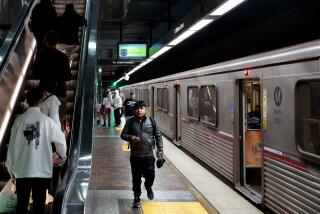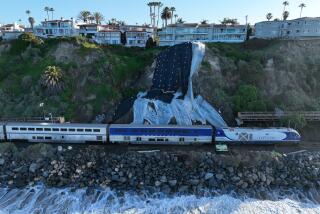MTA Tunneling Machine Stuck Since July 4 Is Freed
With evident relief, a county transit official announced Thursday that a giant subway tunnel digging machine that had become stuck deep in a tricky section of Santa Monica Mountains shale since July 4 has finally been freed.
Metropolitan Transportation Authority construction chief Stanley Phernambucq told the agency’s board members at a committee meeting that the agency’s tunneling contractor had made two major modifications to the machine’s digging mechanism to help it gnaw a bigger hole through the rock.
The extra four inches of diameter, he said, will help prevent the 300-foot-long machine from becoming lodged again in zones of heavily faulted rock that geologists call “squeezing ground.” The machine began to burrow south again at 10:20 a.m, he said.
However, two MTA board members angrily demanded a report detailing the events that led up to the immobilization of the machine over the Fourth of July weekend.
The Times reported Sunday that daily tunnel inspection reports filed by MTA’s construction management consultants described cave-ins and difficulty in installing steel tunnel support ribs three weeks before the holiday. The reports, according to experts contacted by The Times, should have provided ample evidence that the ground was squeezing, making the tunnel smaller, well before the machine became stuck.
Board member Nick Patsaouras tersely told the construction chief that he had been promised a chronology of events by Monday afternoon, and then again by Thursday morning. “I still haven’t seen it yet. . . . You seem to take this so lightly,” he snapped.
Patsaouras also questioned whether the MTA’s engineering consultants had drilled enough deep test borings in the Santa Monica Mountains to determine exactly the type of rock that its tunneling contractor would encounter.
Project manager Charles Stark said geotechnical experts had not yet concluded whether the contractor--Indiana-based Traylor Bros./Frontier-Kemper--or the MTA was at fault for the delay in tunneling in the Cahuenga Pass.
He said that it was the contractor’s responsibility to decide the appropriate way to support its tunnel. The MTA’s contract, he said, specified that the builder could either use six-inch-wide steel ribs to hold up the tunnel, or a heavy grade of steel mesh stapled into place with long metal dowels called expansion bolts.
Before Traylor Bros. began work, he said, its executives received permission to use four-inch-wide steel ribs in certain places rather than the six-inch ribs or expansion bolts.
The first 730 feet of the tunnel were supported by rings of six-inch-wide steel ribs; the next 210 feet were supported by rings of four-inch-wide steel.
“The only mistake, if one was made,” Stark said, “was that we did not switch back to six-inch ribs soon enough.”
More to Read
Sign up for Essential California
The most important California stories and recommendations in your inbox every morning.
You may occasionally receive promotional content from the Los Angeles Times.










